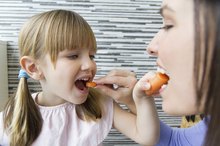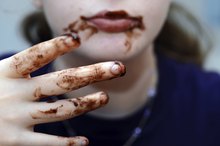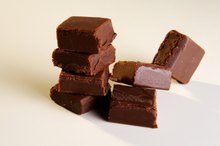What does fact checked mean?
At Healthfully, we strive to deliver objective content that is accurate and up-to-date. Our team periodically reviews articles in order to ensure content quality. The sources cited below consist of evidence from peer-reviewed journals, prominent medical organizations, academic associations, and government data.
- Clinical Pediatrics: Dietary Sensitivities and ADHD Symptoms: Thirty-Five Years of Research
- Clinical Pediatrics: Dietary Sensitivities and ADHD Symptoms: Thirty-Five Years of Research
The information contained on this site is for informational purposes only, and should not be used as a substitute for the advice of a professional health care provider. Please check with the appropriate physician regarding health questions and concerns. Although we strive to deliver accurate and up-to-date information, no guarantee to that effect is made.
Chocolate's Influence on Hyperactivity in Children
Approximately 8 percent of children in the United States younger than 18 have been diagnosed with attention deficit hyperactivity disorder at some point, according to the University of Maryland Medical Center 13. This condition is often treated with a combination of behavioral therapy and medication, but some parents also make changes to their children's diets in hopes of improving their children's symptoms. These changes, which sometimes include avoiding chocolate, are most likely effective in only a very small percentage of children, the center says.
Sugar and Hyperactivity
Sugary foods, including chocolate, are often blamed for hyperactivity in children. The evidence doesn't back this belief up, however, according to an article published in "Pediatrics" in February 2012. There may be a small subset of children who become more inattentive after consuming sugar, but this effect appears to be blocked as long as the children eat a food with protein before or with the food containing sugar.
- Sugary foods, including chocolate, are often blamed for hyperactivity in children.
- There may be a small subset of children who become more inattentive after consuming sugar, but this effect appears to be blocked as long as the children eat a food with protein before or with the food containing sugar.
Chocolate and Hyperactivity
How Diet Affects Children's Behavior
Learn More
In general, chocolate doesn't appear to affect hyperactivity in children. A study published in "Behaviour Change" in March 2006 found that chocolate didn't affect the behavior of preschool children compared to dried fruit, which was used as a control food 2. A review article published in "ARYA Journal" in 2005 came to a similar conclusion, stating that none of the studies reviewed found a connection between chocolate and hyperactivity 5.
Children Sensitive to Chocolate
A review article published in "Clinical Pediatrics" in April 2011 notes that a small subgroup of children with ADHD may be sensitive to artificial food colors and benefit from removing these from their diet. Of this small subset of children, between 65 and 89 percent of children had reactions when given foods containing at least 100 milligrams of artificial food colors. These children also often tend to be sensitive to certain other foods, including chocolate, and may experience fewer symptoms when they avoid these foods.
Other Potential Dietary Interventions
ADHD Meal Plan
Learn More
The Feingold diet, which involves eliminating additives, preservatives, artificial food colors and flavors, and even some fruits that contain substances called salicylates, such as:
- apples
- grapes
- may help improve the hyperactivity symptoms of some children
An elimination diet may help determine which foods to avoid.
Related Articles
References
- University of Maryland Medical Center: Attention Deficit Hyperactivity Disorder
- Behaviour Change: The Effect of Chocolate on the Behaviour of Preschool Children
- Pediatrics: The Diet Factor in Attention-Deficit/Hyperactivity Disorder
- Clinical Pediatrics: Dietary Sensitivities and ADHD Symptoms: Thirty-Five Years of Research
- ARYA Journal: Cacao to Cocoa to Chocolate: Healthy Food?
- Overview of Food Ingredients, Additives & Colors | FDA
- Lack of behavioral effects from Feingold diet violations - PubMed
- Effects of the Feingold diet on seizures and hyperactivity: a single-subject analysis - PubMed
- The Feingold diet: a current reappraisal - PubMed
- Hyperactivity and diet treatment: a meta-analysis of the Feingold hypothesis - PubMed
- The Feingold diet: an assessment of the reviews by Mattes, by Kavale and Forness and others - PubMed
- Artificial food dyes and attention deficit hyperactivity disorder - PubMed
- Diet and ADHD, Reviewing the Evidence: A Systematic Review of Meta-Analyses of Double-Blind Placebo-Controlled Trials Evaluating the Efficacy of Diet Interventions on the Behavior of Children with ADHD - PubMed
- Meta-Analysis of Attention-Deficit/Hyperactivity Disorder or Attention-Deficit/Hyperactivity Disorder Symptoms, Restriction Diet, and Synthetic Food Color Additives
- Dietary sensitivities and ADHD symptoms: thirty-five years of research - PubMed
- Diet and ADHD, Reviewing the Evidence: A Systematic Review of Meta-Analyses of Double-Blind Placebo-Controlled Trials Evaluating the Efficacy of Diet Interventions on the Behavior of Children with ADHD - PubMed
- Meta-Analysis of Attention-Deficit/Hyperactivity Disorder or Attention-Deficit/Hyperactivity Disorder Symptoms, Restriction Diet, and Synthetic Food Color Additives
- Artificial Food Colors and Attention-Deficit/Hyperactivity Symptoms: Conclusions to Dye for
- Artificial food dyes and attention deficit hyperactivity disorder - PubMed
- Diet and ADHD, Reviewing the Evidence: A Systematic Review of Meta-Analyses of Double-Blind Placebo-Controlled Trials Evaluating the Efficacy of Diet Interventions on the Behavior of Children with ADHD - PubMed
- Meta-Analysis of Attention-Deficit/Hyperactivity Disorder or Attention-Deficit/Hyperactivity Disorder Symptoms, Restriction Diet, and Synthetic Food Color Additives
- Artificial Food Colors and Attention-Deficit/Hyperactivity Symptoms: Conclusions to Dye for
- Overview of Food Ingredients, Additives & Colors | FDA
- Artificial food dyes and attention deficit hyperactivity disorder - PubMed
- Overview of Attention Deficit Hyperactivity Disorder in Young Children
- Attention Deficit Hyperactivity Disorder - StatPearls - NCBI Bookshelf
- Color Additives Questions and Answers for Consumers | FDA
- Diet and ADHD, Reviewing the Evidence: A Systematic Review of Meta-Analyses of Double-Blind Placebo-Controlled Trials Evaluating the Efficacy of Diet Interventions on the Behavior of Children with ADHD - PubMed
- Meta-Analysis of Attention-Deficit/Hyperactivity Disorder or Attention-Deficit/Hyperactivity Disorder Symptoms, Restriction Diet, and Synthetic Food Color Additives
- Dietary sensitivities and ADHD symptoms: thirty-five years of research - PubMed
- Effects of restriction on children’s intake differ by child temperament, food reinforcement, and parent’s chronic use of restriction
- Factors Influencing Children’s Eating Behaviours
- Impact of elimination diets on growth and nutritional status in children with multiple food allergies - PubMed
- Effects of restriction on children’s intake differ by child temperament, food reinforcement, and parent’s chronic use of restriction
- Factors Influencing Children’s Eating Behaviours
- Impact of elimination diets on growth and nutritional status in children with multiple food allergies - PubMed
- The psychosocial impact of food allergy and food hypersensitivity in children, adolescents and their families: a review - PubMed
- The psychosocial impact of food allergy and food hypersensitivity in children, adolescents and their families: a review - PubMed
- The relationship between sensory sensitivity, food fussiness and food preferences in children with neurodevelopmental disorders - PubMed
- Picky eating in children: causes and consequences
Writer Bio
Based in Massachusetts, Jessica Bruso has been writing since 2008. She holds a master of science degree in food policy and applied nutrition and a bachelor of arts degree in international relations, both from Tufts University.









